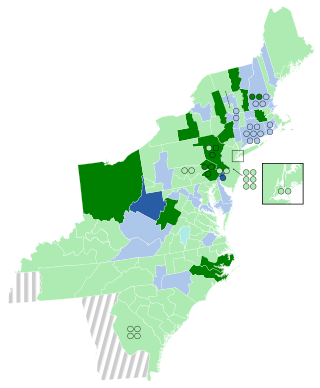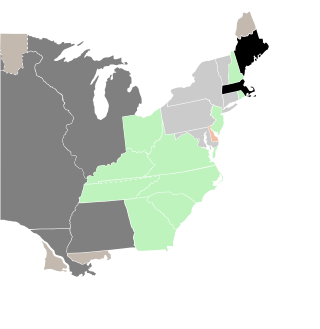A special election was held in Massachusetts's 11th congressional district on October 8, 1810 to fill a vacancy left by the resignation of William Stedman (F) on July 16, 1810. [1]
| Elections in Massachusetts |
|---|
 |
A special election was held in Massachusetts's 11th congressional district on October 8, 1810 to fill a vacancy left by the resignation of William Stedman (F) on July 16, 1810. [1]
| Candidate | Party | Votes [2] | Percent |
|---|---|---|---|
| Abijah Bigelow | Federalist | 2,123 | 72.3% |
| Timothy Whiting | Democratic-Republican | 790 | 26.9% |
| Moses White | Democratic-Republican | 23 | 0.8% |
Bigelow took his seat December 14, 1810 [1]

The 1812–13 United States House of Representatives elections were held on various dates in various states between August 3, 1812 and April 30, 1813. Each state set its own date for its elections to the House of Representatives before the first session of the 13th United States Congress convened on May 24, 1813. They coincided with James Madison being re-elected president.

The 1810–11 United States House of Representatives elections were held on various dates in various states between April 24, 1810 and August 2, 1811. Each state set its own date for its elections to the House of Representatives before the first session of the 12th United States Congress convened on November 4, 1811. They occurred during President James Madison's first term. Elections were held for all 142 seats, representing 17 states.

The 1810–11 United States Senate elections were held on various dates in various states. As these U.S. Senate elections were prior to the ratification of the Seventeenth Amendment in 1913, senators were chosen by state legislatures. Senators were elected over a wide range of time throughout 1810 and 1811, and a seat may have been filled months late or remained vacant due to legislative deadlock. In these elections, terms were up for the senators in Class 2.

The 1808 United States House of Representatives elections in New York were held from April 26 to 28, 1808, to elect 17 U.S. Representatives to represent the State of New York in the United States House of Representatives of the 11th United States Congress. At the same time, a vacancy was filled in the 10th United States Congress.

The 1810 United States House of Representatives elections in New York were held from April 24 to 26, 1810, to elect 17 U.S. Representatives to represent the State of New York in the United States House of Representatives of the 12th United States Congress. At the same time, a vacancy was filled in the 11th United States Congress.

The 1812 United States House of Representatives elections in New York were held from December 15 to 17, 1812, to elect 27 U.S. Representatives to represent the State of New York in the United States House of Representatives of the 13th United States Congress. At the same time, a vacancy was filled in the 12th United States Congress.

The 1814 United States House of Representatives elections in New York were held from April 26 to 28, 1814, to elect 27 U.S. Representatives to represent the State of New York in the United States House of Representatives of the 14th United States Congress.

Kentucky elected its members August 6, 1810.

Maryland held its elections October 1, 1810.

Massachusetts gained three seats after the 1810 Census, all of which were added to the District of Maine. Its elections were held November 5, 1812, but since Massachusetts law required a majority for election, which was not met in the 19th district, a second ballot was held there January 6, 1813.

A special election was held in Connecticut's at-large congressional district on September 17, 1810 to fill a vacancy left by the resignation of Samuel W. Dana (F) in May, 1810 after being elected to the Senate.

A special election was held in Maryland's 7th congressional district to fill a vacancy left by the resignation of John Brown (DR) to accept a position as clerk of the county court of Queen Anne's County. Brown had earlier been re-elected to the 12th Congress, thus, his resignation created vacancies in both the 11th and 12th Congresses. Unusually, a single ballot was used for both vacancies. This was the first of at least three examples of this sort of dual-vacancy being filled with one ballot.

A special election was held in Maryland's 4th congressional district on October 1, 1810 to fill a vacancy in the 11th Congress left by the resignation, on May 14, 1810, of the previous incumbent, Roger Nelson (DR). This election was held at the same time as the general election for the 12th Congress.

Massachusetts held its elections November 5, 1810. Massachusetts law required a majority for election. This was not met in the 15th district necessitating a second election on April 1, 1811.

A special election was held in Massachusetts's 10th congressional district on October 8, 1810, to have Joseph Allen (F) fill a vacancy left by the resignation of Jabez Upham (F).

A special election was held in New Jersey's at-large congressional district on October 30, 1810 to fill a vacancy left in the 11th Congress by the death of James Cox (DR) on September 12, 1810.

A special election was held in New York's 2nd congressional district April 24–26, 1810 to fill a vacancy left by the resignation of William Denning (DR), who had never actually served.
The 1810 United States elections occurred in the middle of Democratic-Republican President James Madison's first term, during the First Party System. Members of the 12th United States Congress were chosen in this election. During the 12th Congress, Louisiana joined the union. Democratic-Republicans continued to control both chambers of Congress.